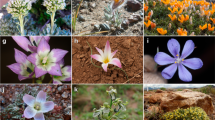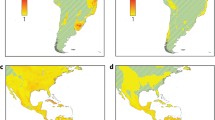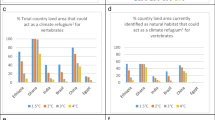Abstract
The elaboration of a comprehensive database about the distribution of the South American genus Nassauvia has allowed investigate its conservation biogeography. The combined use of historical (Dispersal Vicariance Analysis) and ecological (UPGMA) biogeographical approaches has led to detecting past, present and future critical areas in the evolution and persistence of the genus. According to the size of distribution areas, number of locations, environmental niche models, and predicted shifts of these spatial characteristics following the Intergovernmental Panel on Climate Change forecasts for the next decade, it has been possible to award the level of global and national risk for all species of the genus and assign their corresponding IUCN categories. Severe gaps in legal and in situ conservation policies have been detected within the region, making it urgent the adoption of measures aimed at preventing the extinction of the most endangered species. We identify a future dramatic loss of Nassauvia species in the Andes and conversely a species increase in Patagonia. Patagonia has emerged as the cradle of the genus and could be its refuge in the future according the predictions targeted by climate change.








Similar content being viewed by others
References
Akçakaya HR, Butchart SHM, Mace GM, Stuart SN, Hilton-Taylor C (2006) Use and misuse of the IUCN red list criteria in projecting climate change impacts on biodiversity. Glob Chang Biol 12:2037–2043
Araujo MB, Peterson AT (2012) Uses and misuses of bioclimatic envelope modelling. Ecology 93:1527–1539
Austin JJ, Soubrier J, Prevosti FJ, Prates L, Trejo V, Mena F, Cooper A (2013) The origins of the enigmatic Falkland islands wolf. Nat Commun 4:1–7
Baselga A, Orme CDL (2012) betapart: an R package for the study of beta diversity. Methods Ecol Evol 3:808–812
Bellard C, Bertelsmeier C, Leadley P, Thuiller W, Courchamp F (2012) Impacts of climate change on the future of biodiversity. Ecol Lett 15:365–377
Bock CE, Ricklefs RE (1983) Range size and local abundance of some North American songbirds: a positive correlation. Am Nat 122:295–299
Broughton DA, McAdam JH (2002) A red data list for the Falkland Islands vascular flora. Oryx 36:279–287
Broughton DA, McAdam JH (2005) A checklist of the native vascular flora of the Falkland Islands (Islas Malvinas): new information on the species present, their ecology, status and distribution. J Torrey Bot Soc 132:115–148
Brown JH (1995) Macroecology. University of Chicago Press, Chicago
Cabrera AL (1971) XCI. Nassauvia Comm. In: Correa MN (ed) Flora Patagónica, vol 7. Buenos Aires, Buenos Aires, pp 329–358
Cabrera AL (1982) Revisión del género Nassauvia (Compositae). Darwiniana 24:283–379
Cabrera AL, Willink A (1973) Biogeografía de América Latina. Monografía 13. Serie de Biología. Secretaría General de la Organización de los Estados Americanos, Washington DC. EEUU
Cardoso P, Borges PAV, Triantis KA, Ferrandez MA, Martin JL (2011) Adapting the IUCN Red List criteria for invertebrates. Biol Conserv 144:2432–2440
CCAFS (2013) Climate change agriculture and food security. http://www.ccafs-climate.org/data/. Accessed 12 May 2014
Crisci JV, Katinas L, Posadas P (2003) Historical biogeography: an introduction. Harvard University Press, Boston
Crisci JV, Sala OE, Katinas L, Posadas P (2006) Bridging historical and ecological approaches in biogeography. Australian Syst Bot 19:1–10
Cron GV, Balkwill K, Knox EB (2009) Biogeography, rarity and endemism in Cineraria (Asteraceae-Senecioneae). Bot J Linn Soc 160:130–148
Daru BH, van der Bank M, Maurin O, Yessoufou K, Schaefer H, Slingsby JA, Davies TJ (2016) A novel phylogenetic regionalization of phytogeographical zones of southern Africa reveals their hidden evolutionary affinities. J Biogeogr 43:155–166
de la Estrella M, Mateo RG, Wieringa JJ, Mackinder B, Muñoz J (2012) Legume diversity patterns in West Central Africa: influence of species biology on distribution models. PLoS ONE 7(7):e41526
Dudley N (ed) (2008) Guidelines for applying protected area management categories. IUCN, Gland
Elith J, Graham CH, Anderson RP, Dudík M, Ferrier S, Guisan A, Hijmans RJ, Huettmann F, Leathwick JR, Lehmann A, Li J, Lohmann LG, Loiselle BA, Manion G, Moritz C, Nakamura M, Nakazawa Y, McC Overton J, Peterson AT, Phillips SJ, Richardson K, Scachetti-Pereira R, Schapire RE, Soberón J, Williams S, Wisz MS, Zimmermann NE (2006) Novel methods improve prediction of species’ distributions from occurrence data. Ecography 29:129–151
Engler R, Guisan A, Rechsteiner L (2004) An improved approach for predicting the distribution of rare and endangered species from occurrence and pseudo-absence data. J Appl Ecol 41(2):263–274
Fajardo J, Lessmann J, Bonaccorso E, Devenish C, Muñoz J (2014) Combined use of systematic conservation planning, species distribution modelling, and connectivity analysis reveals severe conservation gaps in a megadiverse country (Peru). PLoS ONE 9(12):e114367
Ferro I, Morrone JJ (2014) Biogeographical transition zones: a search for conceptual synthesis. Biol J Linn Soc 113:1–12
Freire SE, Crisci JV, Katinas L (1993) A cladistics analysis of Nassauvia Comm. ex Juss. (Asteraceae, Mutisieae) and related genera. Bot J Linn Soc 112:293–309
Guisan A, Broennimann O, Engler R, Yoccoz NG, Vust M, Zimmermann NE, Lehmann E (2006) Using niche-based models to improve the sampling of rare species. Conserv Biol 20(2):501–511
Hengeveld R, Haeck J (1982) The distribution of abundance. I. Measurements. J Biogeogr 9:303–316
Hijmans RJ, Cameron SE, Parra JL, Jones PG, Jarvis A (2005) Very high resolution interpolated climate surfaces for global land areas. Int J Climatol 25:1965–1978
Hortal J, de Bello F, Diniz-Filho JAF, Lewinsohn TM, Lobo JM, Ladle RJ (2015) Seven shortfalls that beset large-scale knowledge of biodiversity. Annu Rev Ecol Evol Syst 46:523–549
IUCN (2001) IUCN Red List categories and criteria. Version 3.1. IUCN Species Survival Commission, Gland, Switzerland and Cambridge, U.K
IUCN (2010) Guidelines for Using the IUCN Red List Categories and Criteria. Version 8.1. Prepared by the Standards and Petitions Subcommittee in March 2010
IUCN (2012) Guidelines for Application of IUCN Red List Criteria at Regional and National Levels. Version 4.0. IUCN, Gland, Switzerland and Cambridge, U.K
IUCN (2016) Guidelines for Using the IUCN Red List Categories and Criteria. Version 12. Prepared by the Standards and Petitions Subcommittee. http://www.iucnredlist.org/documents/RedListGuidelines.pdf
Jiménez-Alfaro B, Draper D, Nogués-Bravo D (2012) Modeling the potential area of occupancy at fine resolution may reduce uncertainty in species range estimates. Biol Conserv 147:190–196
Kalin Arroyo MT, Marticorena C (1988) A new species of the South American genus Nassauvia (Compositae: Mutisieae) from Chilean Patagonia. Brittonia 40:332–334
Katinas L (1995) Nassauviinae. In: Hunziker AT (dir) Flora Fanerogámica Argentina, fasc. 13, 280. Asteraceae, parte 1, PROFLORA-CONICET, Argentina, pp 5–58
Katinas L (2015) Subtribu Nassauviinae Less. In: Zuloaga FO, Belgrano MJ, Anton AM (eds) Flora vascular de la República Argentina: Dicotyledoneae-Asteraceae (Cichorieae, Helenieae a Mutisieae), vol 7(2). IBODA, CONICET, Buenos Aires, pp 391–486
Katinas L, Gutiérrez DG, Grossi MA, Crisci JV (2007) Panorama de la familia Asteraceae (= Compositae) en la Republica Argentina. Bol Soc Argent Bot 42:113–129
Katinas L, Pruski J, Sancho G, Tellería MC (2008a) The subfamily Mutisioideae (Asteraceae). Bot Rev 74:469–716
Katinas L, Crisci JV, Schmidt Jabaily R, Williams C, Walker J, Drew B, Bonifacino JM, Sytsma KJ (2008b) Evolution of secondary heads in Nassauviinae (Asteraceae, Mutisieae). Am J Bot 95:229–240
Keith DA, Mahony M, Hines H, Elith J, Regan TJ, Baumgartner JB, Hunter D, Heard GW, Mitchell NJ, Parris KM, Penman T, Scheele B, Simpson CC, Tingley R, Tracy CR, West M, Akçakaya HR (2014) Detecting extinction risk from climate change by IUCN Red List Criteria. Conserv Biol 28:810–819
Kraft NJB, Baldwin BG, Ackerly DD (2010) Range size, taxon age and hotspots of neoendemism in the Californian flora. Divers Distrib 16:403–413
Kreft H, Jetz W (2010) A framework for delineating biogeographical regions based on species distributions. J Biogeogr 37:2029–2053
Lessmann J, Muñoz J, Bonaccorso E (2014) Maximizing species conservation in continental Ecuador: a case of systematic conservation planning for biodiverse regions. Ecol Evol 4:2410–2422
Maechler M, Rousseeuw P, Struyf A, Hubert M, Hornik K (2013) Cluster: cluster analysis basics and extensions. R package version 1(14):4
Maraner F, Samuel R, Stuessy TF, Crawford DJ, Crisci JV, Pandey A, Mort ME (2012) Molecular phylogeny of Nassauvia (Asteraceae, Mutisieae) based on nrDNA ITS sequences. Plant Syst Evol 298:399–408
Menini Neto L, Campostrini Forzza R (2013) Biogeography and conservation status assessment of Pseudolaelia (Orchidaceae). Bot J Linn Soc 171:191–200
Morrone JJ (2014) Biogeographical regionalisation of the Neotropical region. Zootaxa 3782:1–110
Morrone JJ (2015) Biogeographical regionalization of the Andean region. Zootaxa 3936:207–236
Nicola MV, Sede SM, Pozner R, Johnson LA (2014) Phylogeography and palaeodistribution modelling of Nassauvia subgenus Strongyloma (Asteraceae): exploring phylogeographical scenarios in the Patagonian steppe. Ecol Evol 4:4270–4286
O’Connor B, Secades C, Penner J, Sonnenschein R, Skidmore A, Burgess ND, Hutton JM (2015) Earth observation as a tool for tracking progress towards the Aichi Biodiversity Targets. Remote Sens Ecol Conserv 1(1):19–28
Odum EP (1983) Basic ecology. Saunders College Publishing, Philadelphia
Ortega-Huerta MA, Peterson AT (2008) Modeling ecological niches and predicting geographic distributions: a test of six presence-only methods. Rev Mex Biodivers 79:205–216
Ortiz EO, Cladera GA (2006) Paleoenvironmental evolution of southern South America during the Cenozoic. J Arid Environ 66:498–532
Ortiz S, Bonifacino JM, Crisci JV, Funk VA, Hansen HV, Hind DJN, Katinas L, Roque N, Sancho G, Susanna A, Tellería MC (2009) The basal grade of the Asteraceae: The fate of Mutisieae (sensu Cabrera) and Carduoideae. In: Funk VA, Susanna A, Stuessy TF, Bayer R (eds) Systematics, Evolution and Biogeography of the Compositae. IAPT, Vienna, pp 193–213
Otley H, Munro G, Clausen A, Ingham B (2008) Falkland Islands State of the environment report 2008. Falkland Islands Government and Falklands Conservation, Stanley
Papes M, Gaubert P (2007) Modelling ecological niches from low numbers of occurrences: assessment of the conservation status of poorly known viverrids (Mammalia, Carnivora) across two continents. Divers Distrib 13:890–902
Pearson RG, Raxworthy CJ, Nakamura M, Townsend Peterson A (2007) Predicting species distributions from small numbers of occurrence records: a test case using cryptic geckos in Madagascar. J Biogeogr 34(1):102–117
Pena de Castro JC, Kamino LHY, Rodrigues M, Mariano-Neto E, de Siqueira MF (2014) Assessing the conservation status of species with limited available data and disjunct distribution. Biol Conserv 170:130–136
Peterson AT (2003) Predicting the geography of species invasions via ecological niche modeling. Q Rev Biol 78:419–433
Phillips SJ, Anderson RP, Schapire RE (2006) Maximum entropy modeling of species geographic distributions. Ecol Model 190:231–259
Ponce JF, Rabassa J, Coronato A, Borromei AM (2011) Palaeogeographical evolution of the Atlantic coast of Pampa and Patagonia from the last glacial maximum to the Middle Holocene. Biol J Linnean Soc 103:363–379
Posadas P (2008) A preliminar overview of species composition and geographical distribution of Malvinian weevils (Insecta: Coleoptera: Curculionidae). Zootaxa 1704:1–26
Posadas P, Crisci JV, Katinas L (2006) Historical biogeography: a review of its basic concepts and critical issues. J Arid Environ 66:389–403
QGIS (2012) Quantum GIS Geographic Information System. Open Source Geospatial Foundation Project, available at: http://qgis.osgeo.org
R Development Core Team (2011) R: A language and environment for statistical computing version 2.13.1.R foundation for statistical computing, Vienna, Austria. Available at: http://www.r-project.org
Ramirez J, Jarvis A (2008) High Resolution Statistically Downscaled Future Climate Surfaces. CGIAR Research Program on Climate Change, Agriculture and Food Security (CCAFS), CIAT, Cali, Colombia
Richardson DM, Whittaker RJ (2010) Conservation biogeography—foundations, concepts and challenges. Divers Distrib 16:313–320
Rivers MC, Taylor L, Brummitt NA, Meagher TR, Roberts DL, Lughadha EN (2011) How many herbarium specimens are needed to detect threatened species? Biol Conserv 144:2541–2547
Ronquist F (1997) Dispersal-vicariance analysis: a new approach to the quantification of historical biogeography. Syst Biol 46:195–203
Salvador S, Chan P (2004) Determining the number of clusters/segments in hierarchical clustering/segmentation algorithms. dissertation, ICTAI 2004, 16th IEEE international conference on tools with artificial intelligence, IEEE, pp 576–584
Sérgio C, Figueira R, Draper D, Menezes R, Sousa AJ (2007) Modelling bryophyte distribution based on ecological information for extent of occurrence assessment. Biol Conserv 135:341–351
Sharrock S (2012) A Guide to the GSPC: All the Targets. Objectives and Facts, Botanic Gardens Conservation International, Richmond
Sneath P, Sokal R (1973) Numerical taxonomy. W. H. Freeman and Company, San Francisco
Syfert MM, Joppa L, Smith MJ, Coomes DA, Bachman SP, Brummitt NA (2014) Using species distribution models to inform IUCN Red List assessments. Biol Conserv 177:174–184
Tortosa RD, Rua G, Bartoli A (2004) A typological analysis of the inflorescences of the genus Nassauvia (Asteraceae). Flora 199:42–46
Upson R, Clubbe C, Hind DJN (2013) Nassauvia falklandica (Compositae: Mutisieae: Nassauviinae), a new endemic species for the Falkland Islands. Kew Bull 68:317–324
Van Der Wal J, Shoo LP, Graham C, William SE (2009) Selecting pseudo-absence data for presence only distribution modeling: how far should you stray from what you know? Ecol. Modell 220:589–594
Vilela B, Villalobos F (2015) letsR: a new R package for data handling and analysis in macroecology. Methods Ecol Evol 6:1229–1234
Walker S, Wilson JB, Steel JB, Rapson GL, Smith B, King WM, Cottam YH (2003) Properties of ecotones: evidence from five ecotones objectively determined from a coastal vegetation gradient. J Veg Sci 14:579–590
Whittaker RH (1972) Evolution and measurement of species diversity. Taxon 21:213–251
WWF and IUCN (1997) Centres of plant diversity. A guide and strategy for their conservation, vol 3 The Americas, IUCN, Cambridge, UK
Yang W, Ma K, Kreft H (2013) Geographical sampling bias in a large distributional database and its effects on species richness-environment models. J Biogeogr 40:1415–1426
Yu Y, Harris AJ, Blair C, He XJ (2015) RASP (Reconstruct Ancestral State in Phylogenies): a tool for historical biogeography. Mol Phylogenet Evol 87:46–49
Zhao X, Valen E, Parker BJ, Sandelin A (2011) Systematic clustering of transcription start site landscapes. PLoS ONE 6:e23409
Acknowledgements
Our gratitude to the curators of revised herbaria. We are indebted to Andrés Moreira Muñoz for providing some localities and clarifying doubts in georeferencing Chilean records. Stephan Beck, Isabel Loza-Rivera, Manuel Macía and Santos Casado kindly shared their information on protected areas in the study region. Rebecca Upson resolved our doubts concerning plant conservation on the Malvinas/Falkland islands and the current status of Nassauvia falklandica. We sincerely thank to the reviewers for their valuable comments in improving the quality and presentation of this paper. MAG, MJA, MV and LK acknowledge the support of Agencia Nacional de Promoción Científica y Tecnológica (ANPCyT), Consejo Nacional de Investigaciones Científicas y Técnicas (CONICET), and Universidad Nacional de La Plata (UNLP). DD is supported by postdoctoral fellowship (SFRH/BPD/100384/2014) of the Portuguese Foundation for Science and Technology (FCT). LP and JCMS acknowledge the support of Dirección General de Investigación Científica y Técnica, Ministerio de Economía y Competitividad (Project CGL2013-48768-P).
Author information
Authors and Affiliations
Corresponding author
Additional information
Communicated by Daniel Sanchez Mata.
This article belongs to the Topical Collection: Biodiversity Conservation and Reserves.
Electronic supplementary material
Below is the link to the electronic supplementary material.
Rights and permissions
About this article
Cite this article
Grossi, M.A., Draper, D., Apodaca, M.J. et al. The road to 2020 targets and the learnings from the emblematic South American plant genus Nassauvia (Asteraceae). Biodivers Conserv 26, 329–351 (2017). https://doi.org/10.1007/s10531-016-1245-0
Received:
Revised:
Accepted:
Published:
Issue Date:
DOI: https://doi.org/10.1007/s10531-016-1245-0




